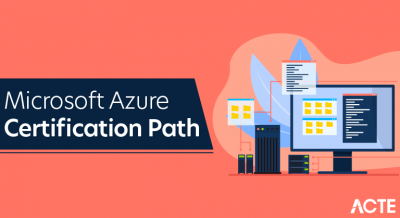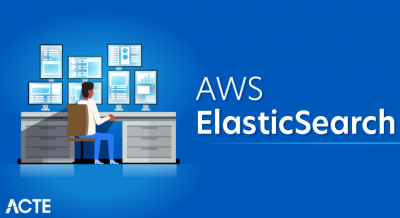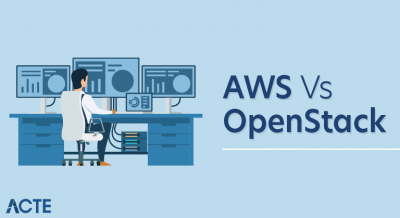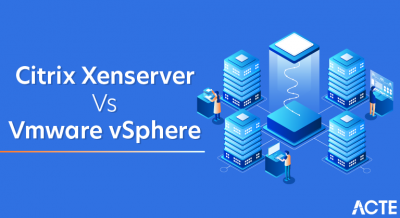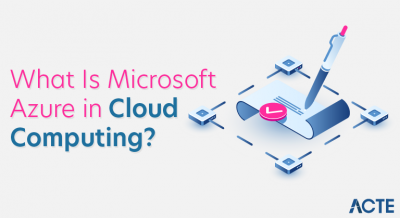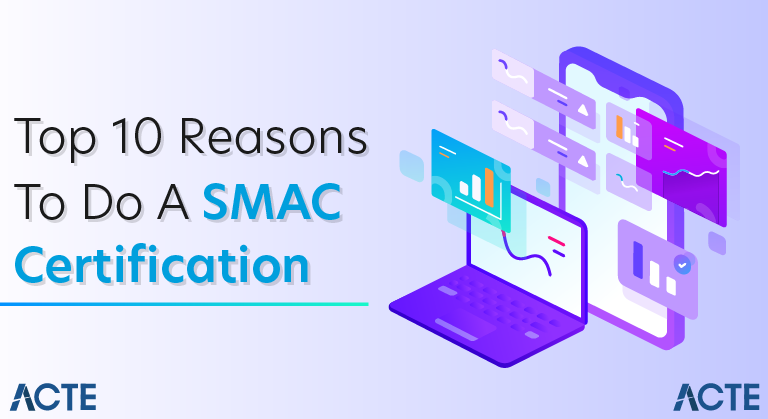
SMAC (social, mobile, analytics and cloud)
SMAC (social, mobile, analytics, and cloud) is the concept that the convergence of four technologies is currently driving business innovation.
SMAC is the basis for an ecosystem that enables a business to transition from e-business to digital business. The four technologies improve business operations and help companies get closer to the customer with minimal overhead and maximum reach. The proliferation of structured and unstructured data created by mobile devices, wearable technology, connected devices, sensors, social media, loyalty card programs, and website browsing is creating new business models built on customer-generated data. None of the four technologies can be an afterthought because it’s the integration of social, mobile, analytics, and cloud together that creates a competitive advantage and new business opportunities.
Evolution and rise of SMAC
The term SMAC was coined in 2011 or 2012 to describe the impact of the consumerization of IT. Enterprise computing consisted of one-to-one communication and of software and hardware that lived on-premises. The introduction of mobile devices and the increased reliance on cloud computing upended the traditional computing model.
The technologies under the SMAC umbrella are as follows:
- Social: Social media platforms such as Twitter, Facebook, Instagram, and Snapchat have provided businesses with new ways to reach, interact with, target, and acquire customers. It has given rise to new job titles such as social media influencer or digital influencer, new marketing tactics such as viral marketing campaigns, and new data sources such as likes, reposts, hashtags, and network connections.
- Mobile: Mobile technologies and platforms such as the iPhone and the iPad, have changed the way people communicate, shop, and work. The introduction of connected devices and wearable devices, both of which rely on cheap sensors to generate and transmit data, are the basis for new business models and new services offered to customers.
- Analytics: Data analytics allows businesses to understand how, when, and where people consume certain goods and services. It is also used as a predictive indicator for future customer behavior as well as when physical assets, such as parts of a jet engine, will experience degradation. As the cost for processing power and storage decreased, analytics became a top priority for companies. The open-source project Apache Hadoop ushered in a new era of analytics called big data.
- Cloud: Cloud computing provides a new way to access technology and the data a business needs to quickly respond to changing markets and solve business problems. It ushered in a new way to build infrastructure, platforms, and services. Amazon Web Services was one of the big disruptors in this space.
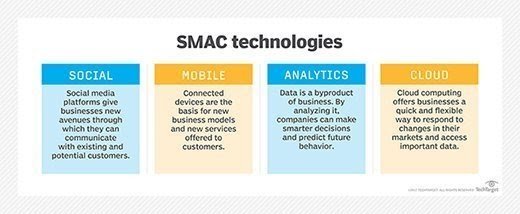
Naming: the so-called third platform
- SMAC isn’t the only term that describes this phenomenon. Other groups coined similar terms around the same time. The Aberdeen Group, a technology, and services company, came up with the term “SoMoClo” or social media, mobile technology, and cloud computing. The consultancy Gartner Inc. described it as the “nexus of forces,” consisting of social media, mobile technology, cloud computing, and information. Gartner now sees the nexus of forces as a precursor to digital business, which it defines as new business models that blur the physical and digital worlds.
- The International Data Corporation (IDC) refers to SMAC as “the third platform.” The first platform was the mainframe, which began in the late 1950s and continues today. The second platform was the client/server model, a concept central to the role of networking where one program requests a service or resource from another program. The third platform is SMAC, a combination of “technology enablers that allow businesses to accelerate their digital transformation,” according to the IDC eBook The Tools Needed to Build a Digitally Native Enterprise. The third platform is accelerated by six innovative technologies including augmented and virtual reality, AI systems, and robotics, according to IDC.
- And some refer to SMAC as the fifth wave of computing. The first wave was the mainframe, the second was the personal computer, and so on. The core idea is that technology innovation doesn’t dismantle an already-established IT architecture; instead, they are cumulative with new technologies built on the wave before it. SMAC is no different.
- More recently, the internet of things (IoT), a network of connected devices that enables the machine to machine communications, is often referenced in relation to SMAC, but exactly where it fits in is still up for debate. IDC considers IoT as one of the six innovation accelerators for the third platform. Some believe IoT belongs under the SMAC umbrella; others see IoT as an extension of the four already-established SMAC pillars.
SMAC and the enterprise
SMAC is the foundation for doing business in a digital economy, where data analytics and information technologies are the backbones and the basis for new business models. Major vendors like Amazon, Facebook, and Google are often held up as paragons of this new world order.
SMAC management plan
A business intelligence consultant explains the corporate role of SMAC.
- Older companies, sometimes referred to as legacy companies, need to undergo significant transformation, often referred to as “digital transformation,” to get there. The transition can be difficult because organizational charts, legacy business processes, and legacy technologies, such as early generation CRM systems, often prove to be a hindrance. The legacy infrastructure doesn’t become obsolete, but it needs to be adapted if it’s going to be of value to a company building digital products and services.
- To take advantage of SMAC technologies, CIOs and IT executives need to change how their department operates and how the technology is architected. One technique that may help instruct CIOs and IT departments on how to make the transition is bimodal information technology or bimodal IT, a term Gartner coined in 2014. Bimodal IT is a two-tiered operations model that enables IT to divide tasks into two modes: processes that are stable, sequential, and slow and processes that require an Agile and iterative approach needed to develop digital products and services.
- Companies are also instituting DevOps teams, a portmanteau of software development and software operations, to bridge two separate departments and increase the pace of building and continuously improving software products and features.
SMAC framework
- Although IDC refers to SMAC as the third platform, no single product exists on the market today. Malcolm Frank, executive vice president of strategy and marketing at the technology services company Cognizant, encourages CIOs to build what he calls a “SMAC stack.” The term is meant to get CIOs thinking about an integrated stack of technology because the value of SMAC is at its greatest when the four technologies are used together. The key is to integrate complex technologies on the backend but provide an easy-to-use customer or employee interface on the front end that masks the complexity.
- To knit together a system that leverages SMAC technologies, CIOs can select proprietary or open-source products to do so, likely building a hybrid stack. Technologies could include NoSQL technologies and machine learning for analytics, cloud services such as integration platform as a service (iPaaS) to manage integration between services and applications, as well as technology that enables the machine to machine communication such as near field communication or Bluetooth low energy beacons to transmit data from a connected device to the cloud. Web APIs can be used to connect social media outlets and cloud services to the platform. The integration of the technologies requires clear policies and guidelines as well as management tools that can automate business processes.
- The media company Netflix is often cited as an example of a business that has successfully harnessed the power of SMAC. For example, when a Netflix member streams a TV show from the Netflix cloud to their iPad, they are given the option of signing into Netflix with Facebook’s social login. After viewing a show, members are given multiple ways to provide social feedback. They can rate content with stars, write reviews, and share what they just watched with friends on Facebook or Twitter. Netflix continues to use social media to build and promote its brand. For example, the company creates original content, and by releasing an entire series of episodes at once, it triggers a social media buzz that gets customers talking and builds up a fan base.
- Customer data is stored in the cloud and Netflix can break down its analysis to such a granular level that its recommendation engine can personalize suggestions for individual family members who share the same account, a concept known as 1:1 marketing. Proponents of this CRM strategy believe that 1:1 marketing (also called one-off marketing) should be the ultimate goal of every SMAC initiative. Critics worry that 1:1 marketing initiatives that aggregate customer data from disparate sources, especially data that is purchased from data brokers, may violate customer privacy and cause legal problems related to compliance and data sovereignty.
The role of the CIO
SMAC enables companies to bring in new sources of revenue and help grow the business. Because technology is becoming a significant part of the DNA for any company, CIOs are well-positioned to break out of the back-office role, if they are so inclined. Examples include Michael Nilles, former CIO at the Schindler Group and now a chief digital officer at Schindler Digital; Thaddeus Arroyo, former CIO and now CEO at AT&T Business; and Jerry Wolfe, former CIO and now CEO at AT&T Business; and Jerry Wolfe, former CIO at McCormick & Co. and now the CEO and founder of Vivanda.

